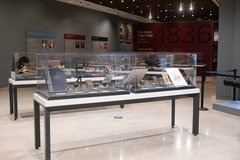These ceramic sherds have been recovered in various units inside and outside of the Long Barrack at the Alamo. The ceramic sherds average 1.1–2.3 inches in dimension and are typically approximately .3 inches thick. Some vessels may have had thicker walls. Typically, Valero Ware are orange in color and often can exhibit a red to red-brown paint for decoration. These vessels were wheel-thrown and were not glazed. The use of the potter’s wheel was introduced by the Spanish.
Valero Ware was first identified during the 1966 excavations at Mission San Antonio de Valero, today more commonly known as the Alamo. It was originally referred to as Red-on-Orange, although excavations during the 1970s led to the ceramic being called Valero or Valero Red Painted. Valero Ware had been encountered at Spanish Colonial sites throughout South Texas, including the other San Antonio Missions. The ware appears limited to Texas.
At other colonial sites, the Valero Ware sherds often represent large vessels that are believed to have held water. The unglazed vessel walls would actually help to cool the water through evaporation. The water would seep through the unglazed vessel walls and evaporate on the exterior, creating a cooling effect.



